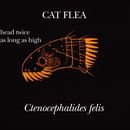Ctenocephalides felis, the cat flea, is a small (~2 mm) common wingless insect found on pets world-wide. Not only is
C. felis the most common of flea species found infesting cats, but in many countries (including the US) it is also the most common flea infesting dogs, as well. Other hosts include a range of domestic and wild mammal species such as raccoons, opossums, skunks, rabbits, squirrels, horses, sheep, cows, goats foxes and coyotes. Although fleas will feed on humans, this occurs only in the absence of a more suitable host; cat fleas cannot carry out their full life cycle on humans. Cat fleas cause bites which are irritating because while biting they secrete chemicals which cause an itchy immune response.
Ctenocephalides felis can transmit parasites to their hosts, as well as to humans (although rarely), including the the double pore dog tapeworm,
Dipylidium caninum. Historically, cat fleas helped spread plague pathogens. This is not generally a problem today in the US, although another species of flea, the Oriental rat flea,
Xenopsylla cheopis is a vector for plague bacteria and a public health concern. While the adult cat flea is a parasite on mammal blood, the larvae, which hatch from eggs that generally fall off and accumulate in the areas in which the host usually sleeps, are scavengers, eating largely dried blood from the feces of adult fleas. The larval and pupal stages can be very rapid (a couple weeks) but
C. felis can also wait out less optimal conditions by remaining in the pupal phase for several months. Cat fleas prefer warmer temperatures (27C-32C) and relative humidity of 75-92, thus are a more problematic pest during summer months. When adults emerge from their pupae they immediately attach to a host (in fact, cues from the host such as vibrations and/or an increase in carbon dioxide stimulate adults to emerge) to feed. Adult cat fleas have powerful hind legs that allow them to jump long distances. Americans spend billions of dollars annually on flea control, treatments, and related vet bills. Flea control measures used to focus primarily on application of insecticides to host pets and the environment. More modern ideas also include use synthetic mimics of insect growth regulator and insect development inhibitor molecules that disrupt the flea's life cycle, as well as stressing the effectiveness of mechanical and cultural control of
C. felis populations (such as vacuuming and strategically locating pet sleeping areas). Pets themselves also reduce flea populations well through regular grooming.
(Rust and Dryden 1997;
Williams and Bennett 2007;
Hill and MacDonald 2009;
Ridge 2000;
Richman and Koehler 20092;
Wikipedia 2011)

